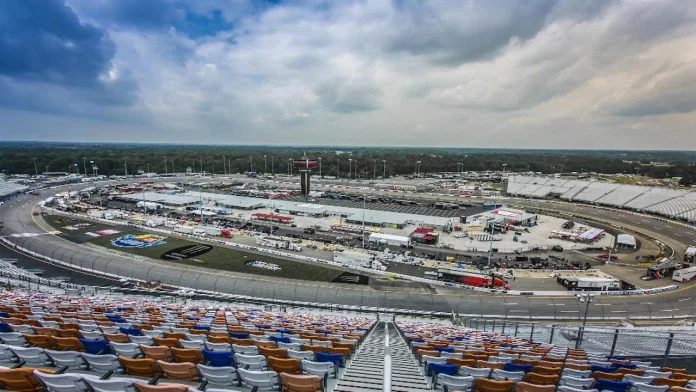Brad Keselowski has issued a significant Brad Keselowski Richmond tire warning prior to the Cook Out 400 at Richmond Raceway, raising concerns about tire durability and strategy as RFK Racing seeks to secure a vital playoff spot. With tensions running high, both drivers and crew chiefs are questioning whether the softer Goodyear option tire will hold up under race conditions—or become a central challenge for teams on Sunday night.
RFK Racing Faces Pressure as Playoff Spots Narrow
With only two races remaining for RFK Racing to clinch a playoff berth, every decision is critical. The team, following patterns from recent years, appears to be hitting its stride as the season ramps up, seen most notably with Ryan Preece claiming pole position. However, team co-owner and No. 6 Ford driver Brad Keselowski has voiced strong apprehensions about the new tire setup determined by NASCAR for Richmond, casting uncertainty over their playoff push.
After NASCAR’s announcement to use Goodyear‘s option tire in the Cook Out 400, Keselowski noted the rubber’s remarkable softness and rapid wear during practice sessions, warning that it may not last beyond 50 laps per set. Such rapid degradation raises the stakes for teams, who have limited tire allotments and little room for error over the course of the event. The 2012 Bill France Cup winner has not been shy about his doubts.
We’re in trouble. The tire’s supposed to be the option tire, it doesn’t look like the option tire, it doesn’t drive like the option tire. It’s going to be harder to run more than 50 laps on it.
—Brad Keselowski, via Kelly Crandall
Kenselowski’s unease has only grown as teams, including his own, calculate potential tire strategies. With the current allocation offering just enough sets for around 45 laps each according to his calculations, the margin for unforeseen issues is razor-thin. Hendrick Motorsports, represented by crew chief Blake Harris for Alex Bowman, has reportedly already asked NASCAR for an extra set of tires, only to be denied.
If you look at the amount of tires we have, we have enough tires to go, I think it’s like 45 laps a set. Rough math. Not enough. The math ain’t mathing.
—Brad Keselowski
Uncertainties Mount Ahead of Race Night
Despite his passionate concerns, Keselowski concedes there is a slim chance the option tire could perform better than feared if nighttime temperatures help prolong its effectiveness, compared to results in the heat of practice sessions. The uncertainty contributes to a charged atmosphere throughout the garage, as teams prepare for what could be an unpredictable event under the lights.
I might be wrong. Maybe something will change and we’ll get into nighttime and the tires will extend their life cycle more than what we’ve seen in practice. But right now, it does not look good.
—Brad Keselowski
These anxieties echo across the paddock, with strategic adjustments on tire wear set to play a pivotal role at Richmond, a track known for its demand on rubber and tactical racing. As teams like RFK and Hendrick Motorsports weigh their options, the focus remains sharply on managing resources—especially for those, like Keselowski, fighting to secure critical playoff positions.
Goodyear Confident Despite Driver Criticism
While several Cup drivers publicly voice their skepticism about the tire selection, Goodyear and its product management team maintain confidence in their choice for Richmond. The call for softer tires has been a longtime plea from both drivers and fans wishing for more dynamic racing, and Goodyear believes it has found the desired balance with this new option tire.
Rick Heinrich, Goodyear product manager, assured the media that performance during preliminary sessions had fallen within expectations, particularly with the targeted degree of tire fall-off, which can create more passing opportunities on race day. Heinrich explained that the run length per set should be manageable, even as teams adapt to the new characteristics.
They’ve really performed spot-on because we’re seeing that kind of fall-off. We’re not seeing people showing that they can’t go as far as they’re going to have to go (Saturday) night. You’re going to have to put at least 37 laps on a set of tires to able to make the math work. We’re seeing people go well beyond that.
—Rick Heinrich
Heinrich’s optimism stands in stark contrast to the concern from Keselowski and other racers, reflecting a deep divide between supplier and competitor perspectives. This divide underscores the tension heading into the event, with Goodyear hinting that Richmond’s outcome could influence tire selection for upcoming races at Martinsville and Phoenix as well.
Tire Performance Set to Decide the Richmond Outcome
The ongoing debate between racer skepticism and manufacturer confidence ensures the Cook Out 400 will be closely watched as teams like RFK Racing, Hendrick Motorsports, and others adjust strategies on the fly. Brad Keselowski’s Richmond tire warning—and his “math ain’t mathing” refrain—reflects broader anxieties for those on the playoff bubble, magnifying every lap as a test of both endurance and calculation.
The outcome at Richmond will not only impact which drivers, such as Keselowski or Ryan Preece, punch their ticket into the playoffs, but may also affect NASCAR’s tire policy for other critical races this season. All eyes are set on how teams manage this dramatic tire challenge, with results likely to send ripples across both pit strategies and the broader direction of Cup Series competition in the weeks ahead.


